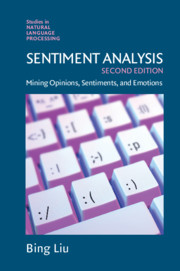Book contents
- Sentiment Analysis
- Studies in Natural Language Processing
- Sentiment Analysis
- Copyright page
- Contents
- Preface
- Acknowledgments
- 1 Introduction
- 2 The Problem of Sentiment Analysis
- 3 Document Sentiment Classification
- 4 Sentence Subjectivity and Sentiment Classification
- 5 Aspect Sentiment Classification
- 6 Aspect and Entity Extraction
- 7 Sentiment Lexicon Generation
- 8 Analysis of Comparative Opinions
- 9 Opinion Summarization and Search
- 10 Analysis of Debates and Comments
- 11 Mining Intent
- 12 Detecting Fake or Deceptive Opinions
- 13 Quality of Reviews
- 14 Conclusion
- Appendix
- Bibliography
- Index
12 - Detecting Fake or Deceptive Opinions
Published online by Cambridge University Press: 23 September 2020
- Sentiment Analysis
- Studies in Natural Language Processing
- Sentiment Analysis
- Copyright page
- Contents
- Preface
- Acknowledgments
- 1 Introduction
- 2 The Problem of Sentiment Analysis
- 3 Document Sentiment Classification
- 4 Sentence Subjectivity and Sentiment Classification
- 5 Aspect Sentiment Classification
- 6 Aspect and Entity Extraction
- 7 Sentiment Lexicon Generation
- 8 Analysis of Comparative Opinions
- 9 Opinion Summarization and Search
- 10 Analysis of Debates and Comments
- 11 Mining Intent
- 12 Detecting Fake or Deceptive Opinions
- 13 Quality of Reviews
- 14 Conclusion
- Appendix
- Bibliography
- Index
Summary
Opinions from social media are increasingly used by individuals and organizations for making purchase decisions and making choices at elections and for marketing and product design. Positive opinions often mean profits and fames for businesses and individuals. Unfortunately, that gives imposters a strong incentive to game the system by posting fake reviews or opinions to promote or to discredit some target products, services, organizations, individuals, and even ideas without disclosing their true intentions, or the person or organization for which they are secretly working. Such individuals are called opinion spammers and their activities are called opinion spamming (Jindal and Liu, 2007, 2008). An opinion spammer is also called a shill, a plant, or a stooge in the social media environment, and opinion spamming is also called shilling or astroturfing. Opinion spamming can not only hurt consumers and damage businesses, but also warp opinions and mobilize masses into positions counter to legal or ethical mores. This can be frightening, especially when spamming is about opinions on social and political issues. It is safe to say that as opinions in social media are increasingly used in practice, opinion spamming is becoming more and more sophisticated, which presents a major challenge for its detection. However, such offenses must be detected to ensure that social media continue to be a trusted source of public opinions, rather than being full of fakes, lies, and deceptions.
- Type
- Chapter
- Information
- Sentiment AnalysisMining Opinions, Sentiments, and Emotions, pp. 304 - 353Publisher: Cambridge University PressPrint publication year: 2020

